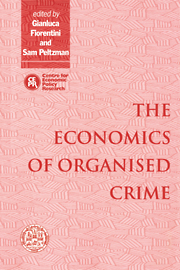Book contents
- Frontmatter
- Contents
- List of figures
- List of tables
- Foreword
- Acknowledgements
- List of conference participants
- 1 Introduction
- PART I THEORIES OF THE STATE AND THE ORIGIN OF CRIMINAL ORGANISATIONS
- PART II THE CRIMINAL ORGANISATION AS A FIRM
- PART III ORGANISED CRIME AND STATE INTERVENTION IN THE ECONOMY
- PART IV DETERRENCE POLICIES AGAINST LEGAL FIRMS INVOLVED IN ILLEGAL ACTIVITIES
- PART V DETERRENCE POLICIES AGAINST ORGANISED CRIME
- 10 Regulating the organised crime sector
- Discussion
- 11 Oligopolistic competition in illegal markets
- Discussion
- Index
Discussion
Published online by Cambridge University Press: 04 August 2010
- Frontmatter
- Contents
- List of figures
- List of tables
- Foreword
- Acknowledgements
- List of conference participants
- 1 Introduction
- PART I THEORIES OF THE STATE AND THE ORIGIN OF CRIMINAL ORGANISATIONS
- PART II THE CRIMINAL ORGANISATION AS A FIRM
- PART III ORGANISED CRIME AND STATE INTERVENTION IN THE ECONOMY
- PART IV DETERRENCE POLICIES AGAINST LEGAL FIRMS INVOLVED IN ILLEGAL ACTIVITIES
- PART V DETERRENCE POLICIES AGAINST ORGANISED CRIME
- 10 Regulating the organised crime sector
- Discussion
- 11 Oligopolistic competition in illegal markets
- Discussion
- Index
Summary
Fiorentini's paper models criminal activity as a game with two stages. In the first stage, criminal groups invest in violence which negatively affects the cost of producing output. In the second stage the criminal group picks output. In each of these stages criminals either compete or cooperate. In the first stage the police choose one of two reactions to violence. Already we have eight possible states-of-the-world, and the paper has more possibilities than those I have mentioned. As is typical of this genre, the paper generates more possibilities than it does clean behavioural implications.
It would be unproductive to go through the catalogue of possible statesof-the-world and the equilibria resulting therefrom. Instead I will focus on some of the paper's more interesting results.
Fiorentini addresses two main questions about the equilibrium level of criminal violence: first, how is it affected by the degree of competition among criminal firms; second, does the police reaction to violence affect this equilibrium? Consider first the case where criminals are competing and total police resources do not respond to changes in criminal violence; the police have ‘low concern’ in Fiorentini's terminology. In this case, if one firm increases violence it confers a benefit on other criminals, because resources, being fixed in total, are drawn away from enforcement against other firms. The first firm ignores this external benefit, so it underproduces violence from the standpoint of the group. If police do respond to more crime with more total resources (the ‘high-concern’ case), there would instead be an external cost imposed by one firm's violence. The extra police resources thereby drawn to fighting crime would raise the costs of the other firms.
- Type
- Chapter
- Information
- The Economics of Organised Crime , pp. 292 - 295Publisher: Cambridge University PressPrint publication year: 1996
- 2
- Cited by

